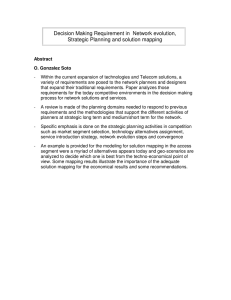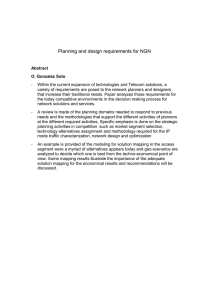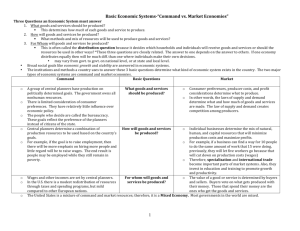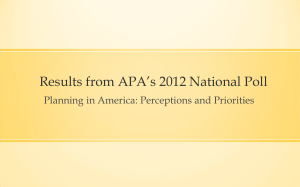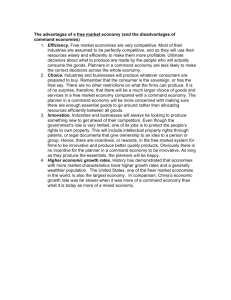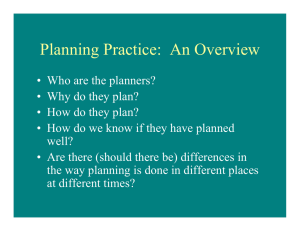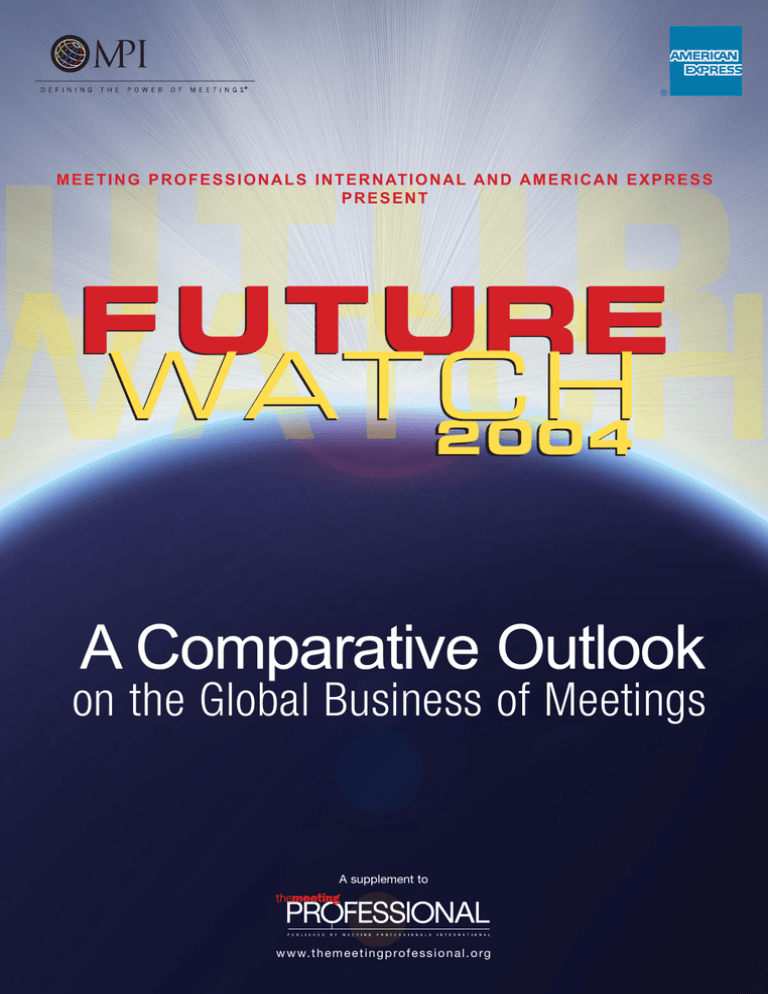
M E E T I N G P R O F E S S I O N A L S I N T E R N AT I O N A L A N D A M E R I C A N E X P R E S S
PRESENT
FUTURE
WATCH
2004
A Comparative Outlook
on the Global Business of Meetings
A supplement to
w w w. t h e m e e t i n g p ro f e s s i o n a l . o rg
Planning a meeting is no small task.
But now, managing the payment is.
The American Express Card can help you simplify
the process of planning and paying for your next event.
®
■
Eliminate time-consuming credit applications
■
Reduce the time you spend and phone calls you make arranging payment
■
Cut the need for purchase orders and company checks
■
Help manage when your vendors process event charges
■
Combine all your event-related expenses onto a single statement
For more information or to apply for the Card, visit www.americanexpress.com/meetingsolutions
© 2003 American Express Company.
Publisher
Colin Rorrie Jr., Ph.D., CAE
Editorial and Design Support
Allison Ellis, Director of Marketing
Bill Voegeli, President, Association Insights
Stacy Clark, Marketing Manager
Gary Rockwood, Graphic Designer
Publications Staff
John Delavan, Director of Publications/Editor in Chief
Blair Potter, Managing Editor
Jason Hensel, Associate Editor
Angela Chiarello, Assistant Editor
Michael Pinchera, Publications Coordinator
Printed by RR Donnelley & Sons Company,
Senatobia, Mississippi, USA
FutureWatch 2004 is an official supplement to the January
2004 issue of The Meeting Professional, the official
publication of Meeting Professionals International, a
professional association of meeting planners and suppliers.
Members receive The Meeting Professional as a
membership benefit paid for by membership dues; $50 of
membership is allotted to The Meeting Professional and is
nondeductible there from. Nonmembers may subscribe to
the publication for $99 annually ($129 international). For
subscription information, deletions and address updates,
call (972) 702-3020 or e-mail publications@mpiweb.org.
File address changes with the U.S. Postal Service online at
www.moversguide.com.
Copyright 2004, Meeting Professionals International,
All Rights Reserved.
TABLE
OF
CONTENTS
4
Summary of Significant
Findings
Examine synopses of the
FutureWatch 2004 survey’s key
revelations.
6
Facts and Figures
Drill down to discover the critical
trends emerging among planners
and suppliers.
Takeaways
11 Key
Review pivotal go-forward
summary recommendations to
build better relationships.
12
Background
Take a closer look at how the
FutureWatch 2004 survey was
conducted.
www.mpiweb.org
WELCOME
to FutureWatch 2004
A comprehensive meeting industry outlook from
Meeting Professionals International (MPI) and
American Express, this highly anticipated report builds
on intelligence from FutureWatch 2003, which was
groundbreaking in its side-by-side perspectives from
meeting planners and suppliers in North America and
Europe. Going a step further, FutureWatch 2004 includes
global industry-first data on the pace of meeting
management and standards, and discloses mutual needs of
buyers and sellers as they work together in the face of an
undisputed industry revolution.
The FutureWatch 2004 survey—which garnered 2,075
responses, of which 54 percent (1,116) were from MPI
planners and 46 percent (959) were from suppliers—
reveals economic and logistical needs such as budgets,
technology, and destination and venue usage. Perhaps
unexpectedly for readers, it also delivers data-supported
dialogue on how meeting planners and suppliers can
collaborate to benefit organizations that host meetings
and the people who attend them. This collective
mindshare on what is needed for those who plan or
service meetings to be best at their jobs underscores the
fact that the business of doing business within the
industry is at a critical juncture.
The forward-focused insights of FutureWatch 2004 come at
a pivotal time in MPI’s history as it leads the transformation
of the meeting industry with Pathways to Excellence, its
strategic plan to drive fundamental change and take
meetings to the next level of professionalism, recognition
and inclusion in the business world. As the leading global
association for the meeting profession with 18,000
members in 60 countries, MPI is distinctly committed to a
50/50 membership ratio of planners and suppliers,
ensuring its unique ability to deliver important industry
intelligence from both sides of the business.
FUTUREWATCH 2004
I 3I
FUTUREWATCH 2004
SUMMARY
of significant findings
Overall Economic and Industry Assessments
In 2004, aggregate economic growth of the North American and European
meeting industry—combined with a resurgence in international travel—points
to a welcome upturn. ❑ The overall size of the meeting industry will grow in 2004,
with likely increases in indicators such as budgets, employment, proposal activity and employee
training. Additionally, a boost is expected in international business travel as U.S. planners forecast a
greater percentage of meetings in multiple locations beyond U.S. borders, and Canadian planners
project a large increase in travel to the United States and Central America.
However, the major divergence in
2003 between projected meeting
planner spend and supplier revenue
continues into 2004. ❑
The pressure on planners to
conserve budgets and on suppliers to
gain greater market share continues,
resulting in the same 7 percent
disparity of last year between the
money that planners are willing or
able to allocate and the revenue that
suppliers must demand.
An average
4 percent growth is
equally projected for meeting planner
and supplier budgets.
A 7 percent gap
remains between
Consultant and independent
planner budgets will continue to
dominate in 2004; however,
corporate planners have regained
considerable ground, reflecting
better overall corporate health. ❑
Budget cuts and downsizing in
2002 and 2003 that resulted in
independent planners gaining
control of the larger average meeting
budgets will be somewhat mitigated
in 2004 as a corporate rebound
brings corporate planning budgets
back to much stronger levels.
However, consultant budgets
skyrocketed, outpacing independents
and corporates by sizable margins
and signaling continued movement
to third-party involvement in the
planning function.
Planners and suppliers agree that
their greatest professional challenge
in 2004 is the improving economy,
followed distantly by global
terrorism. ❑
An improving economy portends
a time when too few people are
asked to perform at even greater
levels while organizations ramp up
after downsizing during the recent
economic decline. The threats of
terrorism and security issues have
become more logistical challenges
than ones of protection. Planners
and suppliers must contend with
contingency issues and alternative
strategies that result from the threat
of terrorist acts.
projected planner spend and
forecasted supplier revenue.
I 4 I FUTUREWATCH 2004
www.themeetingprofessional.org
Planner/Supplier Business Dynamics
Standardized meeting purchasing
policies and procedures are in
place or being adopted in many
organizations, signaling a shift in
how business is conducted. ❑
More than half of all planners
who responded to FutureWatch 2004
indicate they have implemented
some form of organization-wide
meeting purchasing policies and
procedures. Similarly, suppliers say
they are often required to comply
with standardized policies and
procedures with planners and the
organizations they represent.
In 2004, suppliers will continue
technology investments, most aptly
in Web site enhancements. Yet,
efficiencies realized from more tech
use are causing new challenges for
the industry. ❑
The vast majority of meeting
supplier respondents are investing
in Web site enhancements, while
planners expect to use the Internet
more broadly to research venues
and book meetings. Guest room
and wireless solutions and A/V tools
also are marked for sizable supplier
spending, followed by customer
relationship management (CRM)
and online booking and planning
systems. This emergent reliance on
and use of IT has resulted in two
challenging trends. Organizations
feel comfortable allowing for less
lead time, causing planners and
suppliers to work more quickly.
Attendees migrating to the Web to
book outside of room blocks place
a strain on attrition agreements.
www.mpiweb.org
An increasing number of planners and
suppliers agree that commoditization of
the meeting industry is on the rise
again in 2004. ❑
Planners and suppliers agree in
larger numbers that the meeting
industry is employing more
standardization, less personal
contact and more automation. They
also concur that commoditization
will affect the meeting industry
significantly in 2004.
Sales and proposal processes that
emerged in a weak global
economy have resulted in fragile
planner and supplier relationships
in danger of future erosion as the
state of industry improves. At the
root are poor communication and
training issues that have led to
business efficiency challenges. ❑
FACTS
and figures
In 2004, on average, meeting
planner and supplier spending and
revenue projections are equally
4 percent greater than those of last
year. Meeting planners forecast a
3 percent budget increase vs. a
negative 1 percent last year. Suppliers
project a 10 percent growth in
revenue over a 6 percent boost last
year. Interestingly, a 7 percent gap
remains year-over-year as suppliers
stay under pressure to boost revenue
estimates and planners must still
show budget constraint.
As the economy rebounds and
planners seek suppliers with valueadded offerings, the sales and
proposal process must more readily
meet renewed demand for quality
service. This is not easily achievable
under today’s conditions of low
staffing, Web-based marketing
content and other technologies that
erode direct contact. Mutual
confusion about what each other
needs to successfully conduct
business has resulted in re-work,
wasted effort, poor interaction and
even mistrust. Lead and response
times are the most dominant daily
issues, yet they are irrelevant against
a range of rapport problems due to
an overall lack of understanding
and training about each others’
tasks and work flow. ■
FUTUREWATCH 2004 I 5 I
FUTUREWATCH 2004
facts and figures (continued)
More room for optimism?
FutureWatch 2004 employed two
methods to measure year-over-year
planner budget change. One
question asked planners to estimate
percentage change in budgets from
2003 to 2004, to which the average
response equaled a positive 3
percent. Another question asked
respondents to write in actual
budget amounts for 2004. The
average of the write-ins for 2004
compared to 2003 figures points to
an even greater possibility for
growth this coming year.
In total, U.S. and European planners
are equally aggressive in projecting
25 percent average budget increases,
with Canadians at a more conservative
12 percent. Suppliers in the United
States, Canada and Europe are
surprisingly in agreement for 2004,
uniformly projecting 10 percent growth
in 2004 over 2003 budgets.
I 6 I FUTUREWATCH 2004
Conservatively optimistic when
indicating a percent change in
budget, the increase is greater when
comparing actual write-in financial
amounts year-over-year. See chart
below for more detail.
Thriving third parties
Third parties continue to thrive as
evidenced by the fact that independent
planner budgets are anticipated to
grow to $6.5 million in 2004 over a
2003 average of $4.8 million.
Consultants also project a hefty
leap to an average $6.9 million
this year vs. last year’s average of
$3 million. And multimanagement
companies remain steady with a
negligible decline to $2.5 million
from $2.6 million a year ago.
Nevertheless, corporate meeting
budgets regained significant
ground, predicted to rise to
$5.3 million over $4.1 million in
2003, with association and society
planner budgets holding steady at
$1.4 million.
In 2004,
planners expect to consider
4 percent
more facilities or
locations for each meeting
than in 2003.
Suppliers expect
11 percent
more inquiries
and/or proposal activity.
Employment and training up
From 2003 to 2004, employment
is expected to increase in planner
and supplier organizations by an
average of 3 and 4 percent,
respectively. A good sign of support
for this trend is anticipated expansion
of training budgets of 5 percent by
planners and 9 percent by suppliers.
Open-ended suggestions by survey
participants support the importance
of larger employee training budgets
in the coming year as many
frustrations currently experienced by
buyers and sellers are the result of
inadequate training or lack of
experience.
www.themeetingprofessional.org
More international
meetings and travel
In a positive indicator for
international business travel, U.S.
planners expect an 11 percent
growth in international meetings in
2004, twice that of 2003. U.S.
planners now project that 22
percent of all 2004 meetings will be
international, with European
destinations leading at 7 percent,
followed by Canadian locales at 5
percent. In the “no surprises”
category, those who control the
largest meeting budgets are most
likely to hold international meetings
in the coming year.
www.mpiweb.org
Those who plan meetings in
Canada also expect a slightly greater
percentage increase in international
meetings in 2004, as the likelihood
to meet outside of the country
moved from 11 percent in 2003 to
23 percent in 2004.
The United States is expected to
get 11 percent of all Canadian
meetings, and Central America is
predicted to get 4 percent. As in the
United States., Canadian planners
with the largest budgets are most
likely to hold international
meetings.
Overall predicted international
meetings by European planners are
about the same in 2004 as in 2003.
The difference is the significant
increase in projected travel to the
United States with European planners
indicating a 50 percent rise in travel
to U.S. destinations, up to 9 percent
vs. 6 percent of all meetings last
year. A decrease in European
international meetings is expected
in Asia, Africa, the Middle East and
Australia.
While there are shifts in international travel, the venue choices
of U.S., Canada and European
planners remain relatively
unchanged. See charts for more
detail.
FUTUREWATCH 2004 I 7 I
FUTUREWATCH 2004
facts and figures (continued)
Pace of meetings management
Meeting professionals face emerging
challenges and opportunities as new
business practices, broadened use of
technologies and miscommunication
weigh heavily on an enterprise
founded on face-to-face relationships.
In an effort to address conjecture that
meetings management is moving
toward a strategic sourcing model
similar to that of business travel,
FutureWatch 2004 undertook an
industry-first measurement of the pace
of meetings management.
I 8 I FUTUREWATCH 2004
Planners were asked to indicate
the degree to which their organizations
are implementing standards and
practices in areas such as contract
language, registration tools,
meeting request foms, reporting
and reconciliation platforms. About
80 percent indicate consideration of
some form of organization-wide
meetings management practices.
Many have implemented policies
and procedures, and many more
are evaluating practices or are in
some stage of implementation.
Concurrently, 45 percent of meeting
supplier respondents indicate that
more than half the time they conform
to standardized purchasing policies of
planner organizations, with an
additional 22 percent indicating they
comply one-quarter to one-half of the
time. On the other hand, when it
comes doing business, just 14 percent
of supplier respondents say they are
required be a preferred vendor more
than 50 percent of the time, with 44
percent saying the requirement is less
than 10 percent of the time.
www.themeetingprofessional.org
Technology rules
In 2004, meeting planners say
they expect to use the Internet 20
percent more to research meeting
venues, building on the noteworthy
increase of 23 percent in 2003. This
places even greater responsibility on
meeting suppliers to create and
maintain an exceptional Internet
presence leading to further planner
investigation or inquiry. Also
significant is an anticipated 6 percent
rise in the use of the Internet for
actual meeting bookings, surpassing
last year’s increase of 5 percent.
Commoditization concerns
Correspondingly, 83 percent of
supplier respondents in FutureWatch
2004 indicate broad investments in
Web site enhancement as well as
enhanced use of wireless and guest
room technologies. New A/V
equipment also will enjoy a robust
usage hike, with online booking/
planning systems and customer
relationship management
technologies coming in equally on
the list.
When asked what operational
trend would have the greatest
impact in 2004, planners and
suppliers rated organizational
budget changes first, followed by
cancellation and attrition clauses.
There is also increasing concern
about commoditization, a major
trend revealed in FutureWatch 2003.
Eleven percent of planners—up 4
percent from last year—and 13
percent of suppliers indicated
commoditization would have the
greatest effect.
When this information is
combined with data regarding the
expanded use of Internet
technology by planners and
suppliers, and the knowledge that
most planners are at some stage of
implementation of standardized
practices, the meeting industry can
expect commoditization to be an
ongoing trend to watch.
www.mpiweb.org
FUTUREWATCH 2004 I 9 I
FUTUREWATCH 2004
facts and figures (continued)
Business efficiencies
challenge relationships
Another differentiating aspect of
FutureWatch 2004 allowed meeting
planners and suppliers to describe
their working relationships. Those
written descriptions were analyzed
to produce the following summary,
which reveals there is consistency in
responses when it comes to the
types of improvement needed in the
business process to ensure greater
success as the industry recovers.
When suppliers were asked how
planners could work better with
them, suppliers asked for:
• Better and more complete
communication
• More lead time and flexibility
• Honesty regarding budgets and
expectations
• Detailed information regarding
meeting needs
• Teamwork
• Taking time to learn about the
suppliers’ offerings and resources
• Allowance for creativity
When planners were asked how
suppliers could work better with
them, planners asked for:
• More efficient communication
• Quick response to requests and
inquiries
• Better understanding of lead
time and flexibility restraints
• More transparent, understandable
and detailed proposals
• Teamwork
• Continuation of competitive
pricing
• Taking time to learn about
planners’ needs and work flow
• A softer approach to sales and
marketing
Planners and suppliers agree that:
• Complete and concise
communication is often missing
in the proposal process.
• Rework and mistakes result
from poor communication.
• Improvements in communication
efficiency are vital to getting
more accomplished by fewer
people.
• Each needs to take time to learn
about the other’s professional
responsibility and process.
• Openness, honesty and
transparency are needed in
proposals and requests for
proposals.
• Working as a team is a desirable
relationship.
Meeting suppliers and planners should take time to assess how to make
the most of the economic recovery by learning about each other, evaluating
creative ways to protect room blocks, manage attrition and cancellation,
improve communication and streamline the proposal process. ■
The percentages below represent the top five common answers, based on
analysis of more than 2,000 write-in answers from planner and supplier
respondents to the FutureWatch 2004 survey.
What U.S. Planners Need
Most From Suppliers
What Canadian Planners
Need Most From Suppliers
What European Planners
Need Most From Suppliers
Fast response ..............................9%
Be flexible ..................................7%
Use email ....................................6%
Learn/understand
our needs ....................................6%
Better/softer sales
and marketing ............................5%
Fast response ............................15%
Be flexible ..................................7%
Great Web site ............................6%
Detailed quotes ..........................5%
Better/softer sales
and marketing ............................4%
Fast response ............................11%
Be flexible ..................................8%
Honest, clear
communication ..........................7%
Work together/partner
with us ........................................7%
Transparent budgets ..................7%
What U.S. Suppliers Need
Most From Planners
More lead time ........................14%
Complete communication ......13%
Work together/partner
with us ......................................8%
Be honest ....................................6%
Be flexible ..................................5%
I 10 I FUTUREWATCH 2004
What Canadian Suppliers
Need Most From Planners
More lead time ........................15%
More professional
specs/RFPs ................................13%
Complete communication ........9%
Work together/partner
with us ......................................9%
Be flexible ..................................4%
What European Suppliers
Need Most From Planners
More lead time ........................20%
Disclose budget ........................12%
More professional
specs/RFPs ................................12%
Be flexible ..................................7%
Realistic budgets ........................7%
www.themeetingprofessional.org
KEY
takeaways
A consistent theme in the openended responses given by MPI
planners and suppliers is that 2003
was a difficult year marked by hard
work and perseverance. In the face
of downsizing, a shift to technology
and less one-to-one interaction,
numerous adjustments marked the
past year as one of the more
respectable efforts by the meeting
industry in recent years. Entering the
year with little hope for growth,
many faced challenges by accepting
new responsibilities and uncertainties
and testing new ways to work together.
The result was an overall feeling of
successful survival.
Economic trends are the most
significant factors impacting the
meeting industry in 2004. From an
individual perspective, recent
uncertainties have left many feeling
insecure about their futures, often
overworked, and adopting
unfamiliar positions in the
negotiation process.
From an industry perspective,
lowered demand, excess inventories
and concessions have resulted in
poor returns for owners and
investors. As the global economy
improves in 2004, buyers and
sellers are looking forward to a
turnaround. With the upturn comes
lag time between growing demand
and availability of human and
technological resources, training
and education. Qualitative data in
FutureWatch 2004 indicates this lag
time concerns supplier and planner
staff and management.
Planners and suppliers agree, in
increasing numbers, that
commoditization is a critical trend.
As the Internet is used more for
marketing, sales, contracting and
communications, face-to-face
contact among meeting
professionals will further decline.
Standardized procurement and
fulfillment policies will reduce the
amount of time needed to plan and
supply meetings.
In addition, last year’s trend
toward supplier responsibility to
prove the value of meetings will
slow, and possibly reverse by the
end of this year. Beginning in early
2001, economic slowdown and
ensuing safety and travel concerns
allowed more negotiation control
by planners desiring less financial
risk for their organizations. In 2004,
a stronger economy, bigger planner
budgets and more meeting travel
and demand are likely to move
suppliers toward stronger positions
as inventories and services become
in short supply.
Planners demanding low fiscal
risk will continue to focus on
contract and price concessions, but
will find it slightly more difficult as
the year progresses. In fact, write-in
comments from multiple suppliers
in executive roles allude to the fact
that economic recovery may lead to
a shift in control manifested in
higher rates, a return to former
attrition and cancellation clauses
and lessened flexibility.
Some of the hard work of 2003
may be avoided in 2004 if planners
and suppliers will take the time to
train and learn more about each
other, become more understanding
of the challenges in each others’
daily work lives and commit to
bettering communication during
stressful contract and negotiation
interaction.
Fewer planner/supplier
relationships will exist at any one
time, as “preferred” and “approved”
relationships are formed. This trend
should allow the meeting industry
to operate more efficiently, but may
also result in less distinction
between meetings.
www.mpiweb.org
FUTUREWATCH 2004 I 11 I
FUTUREWATCH
2004
background
Total e-mail invitations sent
16,370
Total responses
2,075
Overall response rate
13 percent
In late October 2003, Dallasbased Meeting Professionals
International (MPI), in partnership
with American Express, conducted
FutureWatch 2004 to gather key facts
and comment on meeting industry
trends and indicators in 2004 and
beyond. The survey response
sample was drawn from MPI’s
membership, the world’s best
collective of professional meeting
planners and suppliers. Association
Insights, an independent market
research firm, was contracted for
the second year to conduct this
study, interpret qualitative data and
perform statistical analysis.
Meeting Professionals International
Survey methods for FutureWatch
2004 were evolved to include
open-ended questions fostering
commentary about what planner
and supplier respondents need
from each other to be most effective
in their jobs. This led to more than
2,000 written replies about
professional relationships and
requirements. Each comment and
suggestion was carefully read,
analyzed and made a part of these
findings to deliver the most
comprehensive source of global
meeting planner and supplier
forecasting.
+1.972-702-3000
Methodology: MPI sent e-mail
invitations to 16,370 members
worldwide announcing the study
and requesting participation. All
responses were received
anonymously. Member respondents
were asked to provide a range of
information regarding their
organizational roles, projected
business, organizational challenges,
use of technology, their needs and
more for 2004.
Participation: The survey
garnered 2,075 responses, of which
54 percent (1,116) were from MPI
planners and 46 percent (959) were
from MPI suppliers. Participation
represented nearly 14 percent of
MPI planner members and 12
percent of MPI supplier members.
www.mpiweb.org


